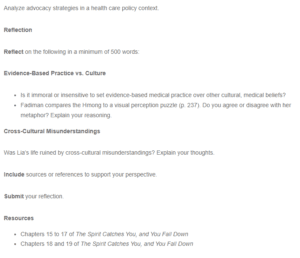Reflecting on the Importance of Evidence-Based Practice and the Clinical Relevance of Culture
Practicing evidence-based practice (EBP) and cultural competence in medicine (CCM) simultaneously can be challenging as the two practices conflict. On the one hand, EBP involves using current best evidence to inform decisions about the type of care given to individual patients. On the other hand, cultural competence requires care providers to understand cultural diversity, integrate it into clinical settings, and respect patients’ values, behaviors, and health beliefs (Hasnain-Wynia et al., 2007). Though these two practices work differently, they share a common goal of improving the quality of care.
Evidence-Based Practice versus Culture
Whether setting evidence-based medicine (EBM) over other cultural medical beliefs is immoral or not is debatable. To elaborate, morals are the codes of conduct established by an individual, a group, or a society (Gert & Gert, 2020); therefore, from this descriptive approach of morality, what a certain individual, group, or society considers morally upright might be considered immoral by others. Nonetheless, I believe failing to consider cultural and other medical beliefs during care is insensitive, especially if a patient’s values, beliefs, and preferences are ignored. Besides, cultural beliefs shape one’s thinking, decision-making, perception of life, and thus health-related behavior. In this regard, culture becomes an important consideration during clinical care, preventive counselling, and when diagnosing, treating, and managing illnesses. It is also worth noting that all clinical encounters are founded on communication, where the patient communicates and shares their values and beliefs, and this is where cultural competence comes in.
Accordingly, cultural competence and awareness among healthcare providers are associated with providing patient-centered care, reducing health disparities, and ultimately improving the quality of care (Lekas et al., 2020). This shows the clinical relevance of culture when providing care, so disregarding a patient’s cultural beliefs would not only be insensitive but also result in poor outcomes and patient dissatisfaction. Conclusively, though evidence-based practice and cultural competency may conflict, incorporating the two would yield high-quality care, reduce health disparities, and increase patient satisfaction.
Fadiman’s Comparison of the Hmong to a Visual Perception Puzzle
Fadiman compares the Hmong of Merced to those visual perception puzzles that reveal different objects or patterns when observed from different angles. I agree with this metaphor because observation of the Hmong of Merced revealed many different things. From one angle, the welfare statistics in Merced seemed “appalling” after the Hmong arrived in the city (Fadiman, 2007). Yet, another angle revealed significant progress in Merced; for instance, there was a 5% decrease in public assistance, the number of graduates and people working in industries increased, and dozens of Hmong women began taking English classes (Fadiman, 2007). Additionally, regarding the Merced school system, an observation from one perspective revealed an overcrowding disaster due to the high multiplication rate of Hmong children. However, an observation from another view showed that Hmong children were hard-working, learned quickly, showed respect, rarely caused disciplinary problems, and were leaders among their peers (Fadiman, 2007).
Cross-Cultural Misunderstandings
Inarguably, cross-cultural misunderstandings initiated and exacerbated Lia’s health problems. From the beginning, Lia’s condition was misdiagnosed twice as “early bronchopneumonia or tracheobronchitis” because the hospital, Merced Community Medical Center (MCMC), lacked a language interpreter (Fadiman, 2007). Lia’s parents, Foua and Nao Kao could not read or speak English, so there was no way to explain the seizures Lia had had before they reached the hospital. The doctors did not know about the seizures, leading the radiologist to conclude Lia had pneumonia. Further, Lia’s health deteriorated due to the conflicting perceptions of her condition held by her parents and the doctors; they could not agree on the best medications for Lia or even the effective method of feeding her. Also, the conflicting cultures and perception of Lia’s illness did not create an opportunity to integrate the Hmong medical practices into Western medicine. Overall, cross-cultural misunderstandings resulting from cultural differences and a language barrier led to misdiagnoses, administering the wrong medications, and the parents resisting and blaming medications for worsening Lia’s condition. Therefore, Lia’s life would possibly have had a better outcome if only the hospital had had a professional interpreter and if the doctors at MCMC had created a cultural rapport with Foua and Nao Kao by familiarizing themselves with the Hmong culture.
References
Fadiman, A. (2007). The spirit catches you and you fall down. Farrar Straus & Giroux Inc.
Gert, B., & Gert, J. (2020, September 8). The definition of morality. Stanford Encyclopedia of Philosophy. https://plato.stanford.edu/entries/morality-definition/
Hasnain-Wynia, R., Pierce, D., Wynia, M., & Johnson, M. (2007). Practicing evidence-based and culturally competent medicine: Is it possible? Commentary 1. AMA Journal of Ethics, 9(8), 572–578. https://doi.org/10.1001/virtualmentor.2007.9.8.oped1-0708
Lekas, H.-M., Pahl, K., & Fuller Lewis, C. (2020). Rethinking cultural competence: Shifting to cultural humility. Health Services Insights, 13, 117863292097058. https://doi.org/10.1177/1178632920970580
ORDER A PLAGIARISM-FREE PAPER HERE
We’ll write everything from scratch
Question

Evidence-Based Practice vs Culture
Analyze advocacy strategies in a health care policy context.
Reflection
Reflect on the following in a minimum of 500 words:
Evidence-Based Practice vs. Culture
- Is it immoral or insensitive to set evidence-based medical practice over other cultural, medical beliefs?
- Fadiman compares the Hmong to a visual perception puzzle (p. 237). Do you agree or disagree with her metaphor? Explain your reasoning.
Cross-Cultural Misunderstandings
Was Lia’s life ruined by cross-cultural misunderstandings? Explain your thoughts.
Include sources or references to support your perspective.
Submit your reflection.
Resources
- Chapters 15 to 17 of The Spirit Catches You, and You Fall Down
- Chapters 18 and 19 of The Spirit Catches You, and You Fall Down

